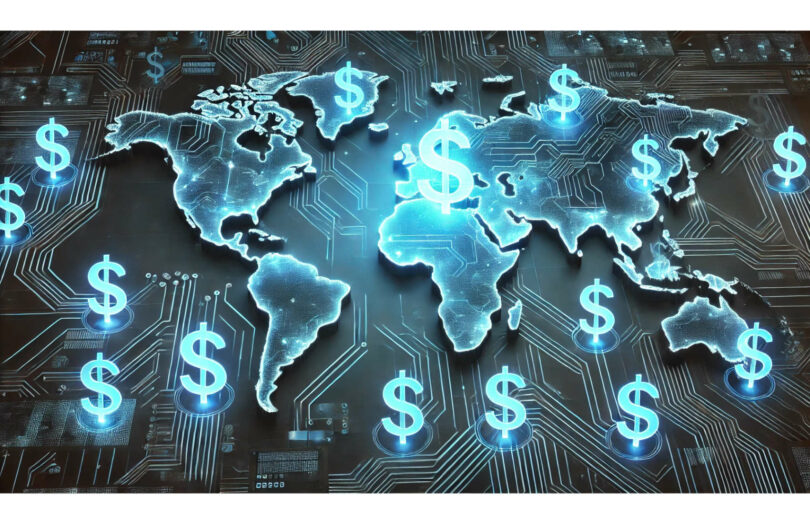For some time there’s been talk of stablecoins replacing eurodollars, but the discussion has accelerated with the new Trump administration. In one of his executive orders, he promoted the idea of dollar stablecoins being used ‘worldwide’. It’s likely the motivation is more about increasing the stock of stablecoins to ramp up demand for US Treasuries, and hence lower the cost of the United States’ enormous borrowing, as stated by crypto czar David Sacks.
The term ‘eurodollar’ refers to any dollar bank deposits held offshore, not just in Europe. It’s a massive market worth around $13 trillion in 2023. At one point it was a figure larger than deposits held in the United States, but the money printing during Covid meant that onshore deposits grew faster.
A key feature of eurodollar payments is that two European banks exchanging dollars with each will clear the payment via a correspondent bank in the United States. Given stablecoins can support direct payments, cutting out the intermediary, the appeal is the potential reduction in friction and cost.
A threat to national security?
Last year former Commodities and Futures Commission (CFTC) Chair Timothy Massad wrote about the potential for stablecoins to replace eurodollar payments and undermine national security. With US banks acting as middlemen in payments, it’s possible to impose sanctions. He argued that unregulated stablecoins could make that trickier. We’d observe that the big stablecoin issuers, including Tether which is based offshore, have complied with many government requests to block wallet addresses.
Stablecoins to replace eurodollars in 20 years?
During a Bloomberg podcast last month, Austin Campbell, an assistant professor at Columbia went a step further when he said, “I think over the next, call it twentyish years, probably the entire eurodollar market is moving to stablecoins.” Mr Campbell has a bit of skin in the game as the CEO of a stablecoin issuer WUSD, where the W stands for world. He said,
“That entire market moving to stablecoins removes a lot of the correspondent banking issues, becomes much cheaper and easier to send money around, and standardizes and makes safer the reserves for the entire eurodollar market. That seems like a very large upgrade to the entire system. My prediction is based on the commercial forces over time will be overwhelming to push you there.”
The blockers for stablecoins in the eurodollar market
Following up on the podcast, a couple more academics at Columbia, Josh Younger and Lev Menand, made the case in a Bloomberg piece for why they’re not convinced about stablecoins replacing eurodollars.
Firstly stablecoin issuers are not banks. They argue that banks have considerably more flexibility. If there’s a sudden influx of money, they can lend it out by offering attractive rates. If there’s a sudden increase in demand for stablecoins amid a tight market for Treasuries, it could create instability. They provide historical examples of similar situations.
We’d observe this approach is a macro view during a crisis situation. Businesses and banks tend to be more short sighted. Hence, in the absence of regulation for offshore stablecoin activities, the attraction of cost savings could win. We’d add that some jurisdictions have already put regulations in place – such as the EU’s MiCA restrictions on the size of foreign currency stablecoins used for payments.
Liquidity is the second reason why Younger and Menand don’t buy into the eurodollar argument. A lot of payments are settled on a net basis, whereas stablecoin payments work on a gross basis. We’d observe that in traditional finance, some are exploring netting DLT transactions, but over more flexible timescales, not just once a day.
The Columbia academics also point to central banks providing liquidity to the banking sector, including swap lines with the Federal Reserve, overnight credit and the like, which stablecoins will not benefit from. Still on liquidity, they highlight the fragmentation of stablecoins across different blockchains, which is often solved via bridges which suffer from security issues.
Stablecoins – what about interest?
Their third point is about whether stablecoins can earn interest. Today most of them don’t which makes them less attractive compared to eurodollar bank accounts.
Since the Bloomberg article, the US has released two stablecoin legislation drafts which allow for interest. Whether that remains in the final legislation remains to be seen, given interest earning stablecoins compete with money market funds, which are subject to different regulations.
US regulations are not the only ones that apply to dollar stablecoins. Again, the EU has set a precedent. MiCA compliant stablecoins are classed as e-money and cannot pay interest. So the Circle USDC available in Europe cannot earn interest, even if the USDC one in the United States could (it doesn’t currently).
Meanwhile, Mr Campbell isn’t the only stablecoin issuer eyeing the eurodollar market. Tether is effectively in the eurodollar market as it operates offshore and is heavily used in Africa. M^0 is another new stablecoin that also plans to remain offshore, expressly targeting the eurodollar market.
It’s still early days for stablecoins. Charlie Munger famously said one should always look at the incentives. One of the biggest challenges for the new US administration is ballooning, expensive government debt. The recognition that stablecoins can help address the cost could see an explicit push towards eurodollar stablecoins, as the Trump executive order stated.






